Contact Point at the Israel Museum is by far the best party of the year – not only a different kind of museum experience, but a monumental event that lets visitors experience the museum in several different ways. There is so much going on that you can’t possibly do everything, but that is part of the mystique.
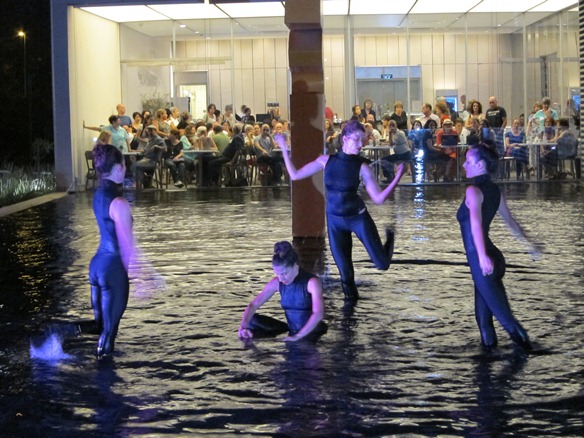
The third annual Contact Point, a joint project of the Jerusalem Season of Culture and the Israel Museum, curated by artistic director, artist, and choreographer Renana Raz, took place on Thursday, July 12, 2012 and as the throngs of people crowding every possible space in and around the museum demonstrated – was a huge success. My own wanderings through the myriad offerings of the night might be called the “fantasy route,” beginning in the pool just outside the Entrance Pavilion, where four dancers (Inbar Nemirovsky, Rosalind Noctor, Einat Betsalel and Ori Josephine Lenkinski) cavorted in the water, performing choreographer Noa Shadur’s “Sparks” – a sensual, provocative and critical look at female icons. Based on Shadur’s stage work “Calypso,” seeing the aquatic adaptation fulfilled some of the fantasy images inspired by that work, and provided vicarious pleasure for all those who can’t see a body of water, especially one that is officially off-limits, without experiencing a strong urge to jump in. I imagine that all those who fantasize about wet nymphets splashing and gyrating in water had fun too.
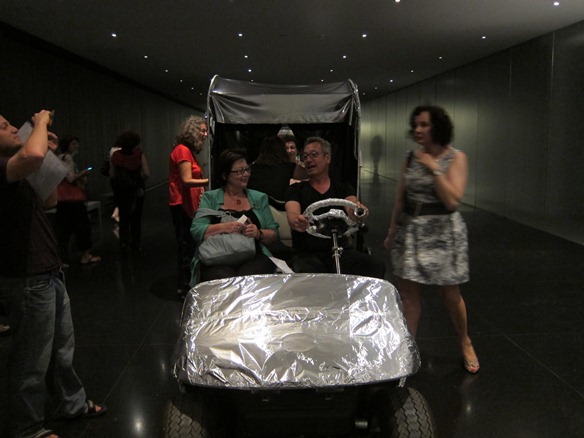
Once inside the museum I soon encountered actor/comedian Shmuel Vilozny surrounded by fans who clamored to enter his silver “Money Cab.” Then it was time to fulfill the ultimate fantasy: painting on the walls of the museum. Students from Bezalel Academy of Arts & Design, Jerusalem Arts Department created a room in which people could express their artistic impulses with paint and other art supplies. Donning blue plastic slippers to enter the room, anyone could go wild with paint – and some did just that, grabbing paint bottles and tossing paint on the wall a la Jackson Pollak, while others concentrated on fine brush strokes.
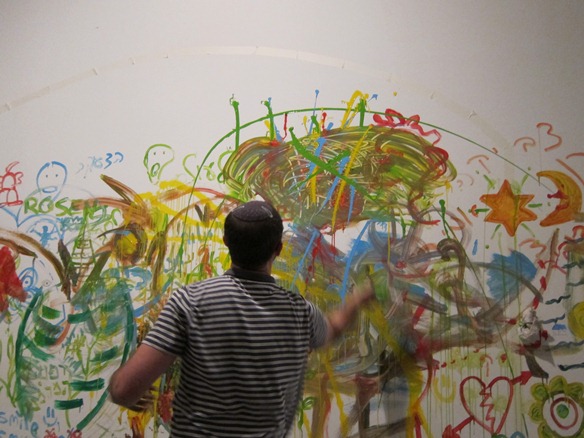
Ohad Meromi’s sculpture Boy from South Tel Aviv, a much-larger-than-life figure, towered over dancer and folk dance instructor Eitan Harari, perhaps best known for his appearance in the award-winning play “Hamarkid” (The Dance Instructor) by Yoav Bartel and Abigail Rubin – Tozeret Bayit Ensemble. Harari is a gifted dancer and an average guy trying to make it in the fiercely competitive world of folk dance, never quite understanding why life doesn’t work out the way he would like it to, yet he never gives up. This night was no exception. For those who know and have danced with Eitan Harari before, the technical problem that occurred with the sound was both a terrible shame, for he could hardly be heard, and at the same time – the event inscribed yet another chapter in the chronicles of Eitan Harari, misunderstood genius.
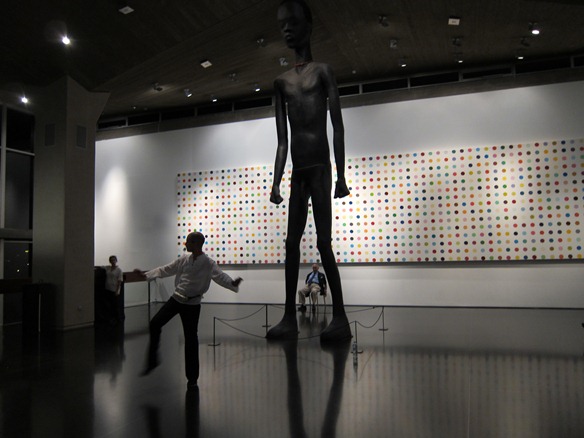
In his inimitable style, Harari persisted against all odds, and the museum visitors who made the effort to be with him despite the technical difficulties had a dance experience that was certainly different, perhaps baffling to first timers, funny and for those who managed to follow Harari’s story, provocative and moving. Known for his transformation of personal experiences into dance creations, Harari shared with the audience the story of a late night walk through the city. Three black men walked behind Harari, who managed to successfully evade them and what one assumes must have been their evil designs on his money or his life. Once safe, he saw three Israeli guys, great guys like you and me, “the salt of the earth,” who seemed perhaps heaven-sent to avenge the three foreigner’s pursuit of Harari, going after the intruders armed with cartons of eggs.
Harari is not one to be defeated by adversity, and he composed a new dance based on this frightening experience. The beauty of Harari’s inspired creations is that the dances are simple enough to learn on the spot, enabling even first-time dancers to join in. Harari gathered the crowd of visitors and invited them to take hands and dance while he called out the instructions. Side step, turn, get your imaginary carton ready, and THROW!!! Standing in the circle of dancers pelting Meromi’s Boy From South Tel Aviv with eggs, the translation of ideology into choreography had a far deeper impact on me than I could have imagined. It was all in fun, and it was, indeed, very funny, and at the same time, Harari’s story and dance inspired a visceral feeling of revulsion in me, even in this imaginary moment, a feeling that permeated my heart, mind and hand. I joined in the dance, went through the motions, I lifted my hand to throw the imaginary eggs – and felt that I just didn’t want to do it.
Needing some air I walked out again to the Billy Rose Art Garden, where I could hear the last songs of Avi Hazamar’s set, and see author Alex Epstein happily ensconced inside Mark Dion’s installation The Antiquarian Book Shop (2008). The writer composed at his laptop, turning now and then to share a smile with the people looking through the windows of the miniature house. Writing is such a solitary task, I wondered if the experience satisfied a fantasy of the author’s as well as the voyeuristic pleasures of the crowds, who also had the Peeping-Tom satisfaction of seeing what Epstein was typing on his computer, as the texts were projected onto Sol Lewitt’s Cube.
Diving deep into the stories and visions of childhood, I joined the people on the Crown Plaza, for a group reading of The Little Prince with Benny Bashan. Benny’s familiar, subversive yet eerily sincere voice recited the book line by line, and we, the make-shift community, heard him through our headphones and spoke the words of Saint-Exupéry’s poetic tale of love. Every now and then, I took off the headphones (yes, I more or less know The Little Prince by heart) and listened to the wonderful sound of us all together. The reading ended with a stirring chorus of “We Shall Overcome” led by the one and only Pete Seeger: deep in my heart, I do believe, we shall live in peace someday.
Someday seems farther and farther away these days, but I do believe that making art, and engaging with art brings us closer – if not to peace, then at least closer to one another, which is a step in the right direction. I ended my Contact Point experience with the silent WI party, music coming in through my headphones. It was a two-track party with DJs Ophir Toubul and Balkadan (Laissez-Passez) on one channel, Rob & Sabbo (Soulico) on the other. You could dance to Laissez-Passez’s groove while your partner danced to Soulico’s selections; you could switch from one to the other at the touch of a button. A huge party of smiling happy people, each one listening to an individual soundtrack, dancing together; maybe that’s what peace looks like.

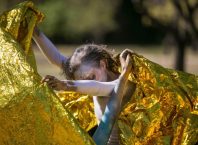


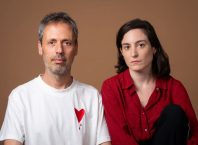
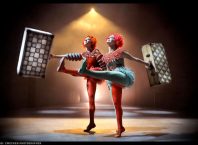
[…] what I had to say after last year’s summer night spent at the museum, read on (click here) for details of the event and my adventures. Don’t hesitate, mark your calendars and get your […]
[…] the back, right behind several hundred others) and more recently enjoyed his unique take on life at Contact Point at the Israel Museum. Looking forward to becoming better acquainted with the musician and his music – and so […]
Such a fascinating description. Thanks Ayelet
Comments are closed.